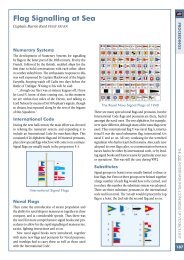The International Brigades in the Spanish War ... - The Flag Institute
The International Brigades in the Spanish War ... - The Flag Institute
The International Brigades in the Spanish War ... - The Flag Institute
You also want an ePaper? Increase the reach of your titles
YUMPU automatically turns print PDFs into web optimized ePapers that Google loves.
5. BATERIAS<br />
Fig 45b<br />
<strong>The</strong>re was a total of 21 <strong>International</strong> Batteries; from <strong>the</strong>m<br />
we only know one flag: <strong>the</strong> Gottwald anti-flight battery.<br />
5.1. Gottwald<br />
This was an anti-flight battery, created <strong>in</strong> January 1937<br />
and formed by Czechs, Slovaks and Yugoslavians. Demobilised<br />
on September 25, 1938, after hav<strong>in</strong>g shot down<br />
51 aeroplanes.<br />
<strong>The</strong>ir standard was a gift of <strong>the</strong> “siderurgia” of Sagunto<br />
workers’ <strong>in</strong> May 1938. Now it is <strong>in</strong> <strong>the</strong> Military Museum<br />
of Prague and on <strong>the</strong> front side, over <strong>the</strong> republican<br />
tricolours, <strong>in</strong> white letters, is <strong>the</strong> text: “Los obreros de la<br />
siderúrgica de Sagunto a la 17 Batería DECA” (Fig. 46).<br />
Fig. 46<br />
Klement Gottwald (Dedice, Moravia 1896 – Praga<br />
1953): Czech politician. Militant of <strong>the</strong> social democrat<br />
and of <strong>the</strong> communist party ever s<strong>in</strong>ce its foundation<br />
(1921). Secretary of <strong>the</strong> Czech communist party,<br />
he went to <strong>the</strong> USSR (1938-1945). At his return he was<br />
president of <strong>the</strong> counsel (1946) and organised (1948)<br />
<strong>the</strong> coup that gave <strong>the</strong> power to <strong>the</strong> Communists<br />
President of <strong>the</strong> Republic between 1948 and 1953.<br />
6. BASE Y ESCUELAS<br />
Apart from <strong>the</strong> Base of Albacete, <strong>the</strong> <strong>in</strong>ternational brigades<br />
organised <strong>the</strong> Superior Military School and <strong>the</strong><br />
School of Officers of Pozorrubio which, probably, had<br />
<strong>the</strong>ir own flags.<br />
6.1. Base Albacete<br />
<strong>The</strong> General Headquarters of <strong>the</strong> <strong>International</strong> <strong>Brigades</strong><br />
was seated <strong>in</strong> Albacete, because of <strong>the</strong> premises disposed<br />
<strong>the</strong>re by <strong>the</strong> communist “5º Regimiento”. Afterwards, <strong>in</strong><br />
April <strong>the</strong>y moved to Barcelona to a villa <strong>in</strong> Horta and on<br />
<strong>the</strong> Tibidabo mounta<strong>in</strong>.<br />
<strong>The</strong> flag of <strong>the</strong> “Base. Estado Mayor. Albacete” was paid<br />
by a people’s subscription, and sent to <strong>the</strong>m <strong>in</strong> October<br />
1937. It is almost square ~1x1 m; <strong>in</strong> <strong>the</strong> obverse <strong>the</strong>re<br />
was a big red five-po<strong>in</strong>ted star and text and fr<strong>in</strong>ge <strong>in</strong> gold;<br />
<strong>the</strong> reverse was different: star, rays and probably, <strong>the</strong><br />
three-po<strong>in</strong>ted star of <strong>the</strong> <strong>International</strong> <strong>Brigades</strong> (Fig. 47).<br />
7. AVIACION<br />
Fig. 47<br />
<strong>International</strong> volunteers jo<strong>in</strong>ed <strong>the</strong> Republican Air<br />
Forces, basically, <strong>in</strong> four squadrons:<br />
<strong>The</strong> “Escuadrilla España”, organised by <strong>the</strong> French<br />
writer André Malraux, member of <strong>the</strong> Anti-fascist World<br />
Committee. Created <strong>in</strong> Barcelona <strong>in</strong> July 1936, <strong>the</strong>y<br />
moved to Madrid on August 16, 1936. This squadron<br />
flight was <strong>in</strong>creas<strong>in</strong>g until half a hundred aeroplanes<br />
and three hundred people (pilots and o<strong>the</strong>r personnel).<br />
In <strong>the</strong> “Grupo 11 de Caza Nieuport 52” with base<br />
<strong>in</strong> Getafe <strong>the</strong>re were <strong>the</strong> Soviet pilots, first arrived to test<br />
<strong>the</strong> aeroplanes, and some British and Italians.<br />
Also <strong>in</strong> <strong>the</strong> “Escuadrilla de Bombardeo” based <strong>in</strong><br />
Alcalá de Herares <strong>the</strong>re were Soviet pilots who tested<br />
<strong>the</strong> Breguet XIX and some French, Hungarian and Italian<br />
pilots.<br />
In <strong>the</strong> “Grupo 14 de Caza Nieuport NI-52” and <strong>in</strong><br />
<strong>the</strong> air force based <strong>in</strong> Bilbao and Lamiaco, <strong>the</strong>re were<br />
also some <strong>in</strong>ternational volunteers.<br />
PROCEEDINGS<br />
157






